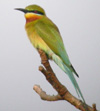INTRODUCTION
Having changed our car earlier this year, funds were a little depleted, putting on hold any plans for birding exotic locations until said funds are replenished. With such restraints we decided to expand our photographic album of British birds. With many of the iconic Scottish birds still required we decided to visit locations which would give us a fighting chance of bagging a few.
TIREE
Our first port of call was the Isle of Tiree: this island holds a good number of Corncrakes; a bird very high up on our wanted list. We allowed ourselves 2 full days to capture this very elusive bird. 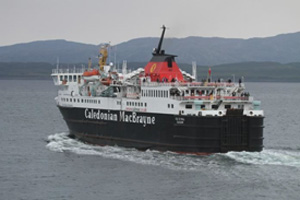 We arrived at the ferry terminal in Oban at 04-45 having spent the previous night at the “Falls Of Lora” hotel in nearby Connell. Our boat left on the dot at 05-45 for the 4hr crossing. The seas were calm, and the weather was dry with a cold breeze. Suitably attired we spent the first 2hrs on the upper deck before chilled bones and the distant aroma of bacon forced us below for a hot breakfast. Refreshed, we returned to our posts on the upper deck where we spent the rest of the trip. Sightings for the crossing were very poor with just a handful of common species seen; these included 4 Black Guillemot, 2 Gannet, various gulls and several small rafts of Common Guillemot. 2 Great Northern Diver were seen as we berthed at Tiree jetty.
We arrived at the ferry terminal in Oban at 04-45 having spent the previous night at the “Falls Of Lora” hotel in nearby Connell. Our boat left on the dot at 05-45 for the 4hr crossing. The seas were calm, and the weather was dry with a cold breeze. Suitably attired we spent the first 2hrs on the upper deck before chilled bones and the distant aroma of bacon forced us below for a hot breakfast. Refreshed, we returned to our posts on the upper deck where we spent the rest of the trip. Sightings for the crossing were very poor with just a handful of common species seen; these included 4 Black Guillemot, 2 Gannet, various gulls and several small rafts of Common Guillemot. 2 Great Northern Diver were seen as we berthed at Tiree jetty.
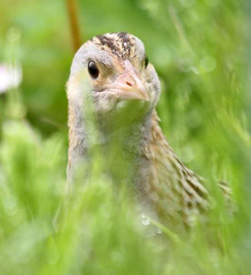 With heavy rain forecast for later that day we decided to go straight for the area we had been informed gave us the best chance of connecting with our prime objective, the Corncrake. With windows down we drove slowly until we detected the unmistakable rasping call of our quarry. It now appears that we were very fortunate indeed because we had stumbled across a pair of Corncrake in a territorial dispute, both birds had abandoned all sense of concealment and were charging around the field disputing territorial ownership. In less than an hour we had managed to bag what we thought was going to be one of the most difficult birds of the trip. Several other birds were encountered during that afternoon with 1 individual running across the road in front of us. With the forecasters being totally accurate for once, the weather deteriorated that afternoon; firstly drizzle then heavy rain which set in for the next 2 days. All we could do was slowly drive around the byways of Tiree.
With heavy rain forecast for later that day we decided to go straight for the area we had been informed gave us the best chance of connecting with our prime objective, the Corncrake. With windows down we drove slowly until we detected the unmistakable rasping call of our quarry. It now appears that we were very fortunate indeed because we had stumbled across a pair of Corncrake in a territorial dispute, both birds had abandoned all sense of concealment and were charging around the field disputing territorial ownership. In less than an hour we had managed to bag what we thought was going to be one of the most difficult birds of the trip. Several other birds were encountered during that afternoon with 1 individual running across the road in front of us. With the forecasters being totally accurate for once, the weather deteriorated that afternoon; firstly drizzle then heavy rain which set in for the next 2 days. All we could do was slowly drive around the byways of Tiree.
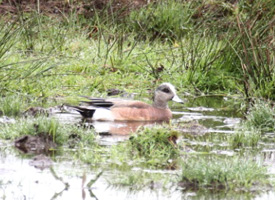 Peering through rain spattered misted windows is not ideal conditions for birding, let alone photography - morale was tested to the limit. We had been tipped off by John Bowler (RSPB) that the American Wigeon was still about; after 3 visits to its favourite haunt during the next 2 days we finally caught up with the little devil and managed to get a very distant shot. John also mentioned a Turtle Dove associating with some Collared Doves, but several attempts to locate the bird proved fruitless.
Peering through rain spattered misted windows is not ideal conditions for birding, let alone photography - morale was tested to the limit. We had been tipped off by John Bowler (RSPB) that the American Wigeon was still about; after 3 visits to its favourite haunt during the next 2 days we finally caught up with the little devil and managed to get a very distant shot. John also mentioned a Turtle Dove associating with some Collared Doves, but several attempts to locate the bird proved fruitless.
It is not our way to be scathing when remarking on places we stay at; we usually try to be fair and positive, but in this report we are going to make an exception. There are 2 hotels on the Island; one was shut and the other one should have been. 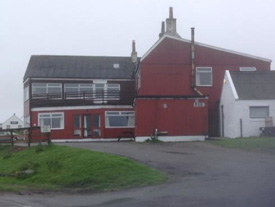 It was our misfortune to choose the “Scarinish Hotel” despite the many complaints on Trip Advisor; we didn’t think it could be that bad - believe us it can and more. We would rather spend a night in an upturned boat in the harbour than return there. The overpowering stench of old cooking oil will live long in the memory. The management of the hotel had a very indifferent attitude, an almost couldn’t care approach: the staff on the other hand tried their hardest to please but spent most of the time apologising for the ineptitude of the management.
It was our misfortune to choose the “Scarinish Hotel” despite the many complaints on Trip Advisor; we didn’t think it could be that bad - believe us it can and more. We would rather spend a night in an upturned boat in the harbour than return there. The overpowering stench of old cooking oil will live long in the memory. The management of the hotel had a very indifferent attitude, an almost couldn’t care approach: the staff on the other hand tried their hardest to please but spent most of the time apologising for the ineptitude of the management.
Due to the poor weather during our stay both birding & photography were badly curtailed. However, migration was still in progress so small flocks of Dunlin, Sanderling and Ringed Plover were evident at almost every suitable piece of coastline. Flocks of 14 & 5 Whimbrel were seen on the second & third days respectively. A small influx of Little Stint was encountered on Gott Bay on the second day. Large numbers of Oystercatcher and Lapwing nested in the damper areas, many with well grown chicks. Lesser numbers of Redshank and Snipe also breed. Most of the larger bays contained several lingering Great Northern Diver, resplendent in summer plumage; Gott Bay was still holding up to a dozen. Starlings were abundant.
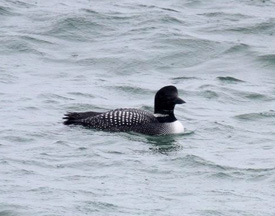 Birds recorded during our stay on Tiree
Birds recorded during our stay on Tiree
Great Northern Diver, Goosander, Shag, Black Guillemot, Guillemot, Mallard, Greylag Goose, Mute Swan, Grey Heron, Greater Black-backed Gull, Common Gull, Black-headed Gull, Herring Gull, Fulmar, Arctic Tern, Little Tern, Coot, Buzzard, Lapwing, Dunlin, Sanderling, Turnstone, Ringed Plover, Oystercatcher, Little Stint, Redshank, Whimbrel, Snipe, Eider, Shelduck, American Wigeon, Starling, Blackbird, Song Thrush, Meadow Pipit, Northern Wheatear, Pied Wagtail, Skylark, Corncrake, Stonechat, Linnet, House Sparrow, Swallow, Sand Martin, Stock Dove, Collared Dove, Hooded Crow, Raven and Pheasant.
Due to the very wet weather during our stay the number of bird species seen was quite low and probably isn’t representative of the numbers on the Island. However, our main objective was the Corncrake and that we achieved in spades.
FORT WILLIAM
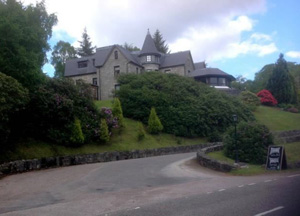 With a couple of days to kill before our accommodation was free on Eigg we decided to spend them in the Fort William area. This was mainly due to being informed of a Blackcock lek that was accessible by car; birds were said to display within 100 metres of the vehicle, allowing good photographic opportunities, weather conditions permitting of course.
With a couple of days to kill before our accommodation was free on Eigg we decided to spend them in the Fort William area. This was mainly due to being informed of a Blackcock lek that was accessible by car; birds were said to display within 100 metres of the vehicle, allowing good photographic opportunities, weather conditions permitting of course.
Our Ferry left Tiree at 12-25, calling at Coll and getting to Oban at 16-30. We then had the 1 hour drive to our chosen hotel the “Glenspean”. What a difference a hotel makes - a wonderful room, great food, and owners who really cared about their reputation and that of the hotel. Located some 20 minutes drive outside Fort William in the Spean Valley 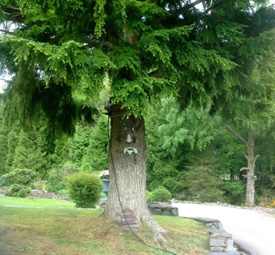 it had commanding views of the snow capped Grampian Mountains with a tantalising view of Ben Nevis's peak. Visiting Pine Martens, regular views of fly-by Golden Eagles, mature gardens set in woodlands and 2 well stocked bird feeding stations make this a great hotel for birders, we would highly recommend it.
it had commanding views of the snow capped Grampian Mountains with a tantalising view of Ben Nevis's peak. Visiting Pine Martens, regular views of fly-by Golden Eagles, mature gardens set in woodlands and 2 well stocked bird feeding stations make this a great hotel for birders, we would highly recommend it.
Having thought we had left the rain on Tiree we awoke on our first morning to more of the same, leaden skies and rain. John Chester, who we met on Lesvos in 2009, had informed us that Glen Nevis would be worth a visit, “nothing special, but a few birds of interest” said his email. With the rain continuing to fall very little was seen at both the Glen Nevis visitor centre and the Forestry Commission picnic site. Cutting our losses we took the Nevis Range cable car looking for hardier birds at the higher altitude, but again little was prepared to show in the wet, drab conditions.
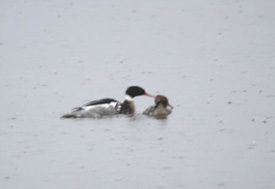 Rising at 04-00 to leaden skies we took the gamble and tried for the Black Grouse at the lek. Visibility was poor but we could clearly see & hear 7 males and it wasn’t long before we were witnessing jousting birds. By 05-15 the light had improved and we were hopeful for some decent photos, our hopes were soon dashed, heavy rain again set in. We abandoned any hopes of meaningful birding and after returning to the hotel for a well earned breakfast we decided to drive up to Mallaig and check out the parking and the layout of the ferry terminal. We did have a quick look at Loch Morar en-route; John had identified this Loch as possibly holding Black-throated Diver, but a pair of displaying Red-breasted Merganser was all we could find (note the raindrops on the water).
Rising at 04-00 to leaden skies we took the gamble and tried for the Black Grouse at the lek. Visibility was poor but we could clearly see & hear 7 males and it wasn’t long before we were witnessing jousting birds. By 05-15 the light had improved and we were hopeful for some decent photos, our hopes were soon dashed, heavy rain again set in. We abandoned any hopes of meaningful birding and after returning to the hotel for a well earned breakfast we decided to drive up to Mallaig and check out the parking and the layout of the ferry terminal. We did have a quick look at Loch Morar en-route; John had identified this Loch as possibly holding Black-throated Diver, but a pair of displaying Red-breasted Merganser was all we could find (note the raindrops on the water).
Buoyed by the prospect of better weather the next day we decided to try for the Blackcock again. The weather wasn’t quite as bright as forecast but the light was better than the previous day and it was dry. 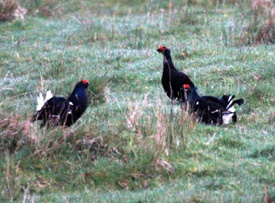 We left the hotel at 04-10 arriving at the lek a shade after 04-30. 2 birds were visible, although they appeared to take little notice of each other; it wasn’t until 4 more birds flew in that the displaying started in earnest. Hissing and popping with heads lowered and tails flared, the birds postured at anything that entered their line of sight. We had grandstand seats of birds approximately 50metres away, their expelled breath clearly visible in the early morning chill. The low cloud began to drop lower, a prelude to more rain, curtailing any improvement in light conditions and making photography more challenging than we had hoped. As happened the previous day, the birds began to lose interest and melt away by 05-45, how good a breakfast can taste following a morning like that. Breakfasted by 07-45 we were on the road to Mallaig by 08-00 for the 10-15 ferry to Eigg.
We left the hotel at 04-10 arriving at the lek a shade after 04-30. 2 birds were visible, although they appeared to take little notice of each other; it wasn’t until 4 more birds flew in that the displaying started in earnest. Hissing and popping with heads lowered and tails flared, the birds postured at anything that entered their line of sight. We had grandstand seats of birds approximately 50metres away, their expelled breath clearly visible in the early morning chill. The low cloud began to drop lower, a prelude to more rain, curtailing any improvement in light conditions and making photography more challenging than we had hoped. As happened the previous day, the birds began to lose interest and melt away by 05-45, how good a breakfast can taste following a morning like that. Breakfasted by 07-45 we were on the road to Mallaig by 08-00 for the 10-15 ferry to Eigg.
Birds recorded during our stay at Fort William
Red-breasted Merganser, Black Grouse, Buzzard, Swallow, House Martin, Cuckoo, Song Thrush, Great Spotted Woodpecker, Pied Wagtail, Coal Tit, Blue Tit, Great Tit, Chaffinch, Greenfinch, Willow Warbler, Northern Wheatear, Wood Pigeon and Hooded Crow.
ISLE OF EIGG
Just like our crossing to Tiree, the ferry left spot on time and just like that crossing little was seen, just a few small rafts of Guillemot & Razorbill, half a dozen singleton Manx Shearwater and a few fly-by Gannet.
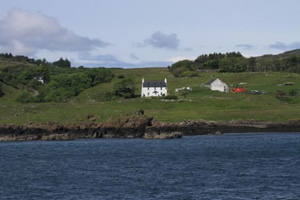 John Chester had arranged to meet us off the ferry but was nowhere to be seen. Seeing the look of bewilderment on our faces a chap standing next to a green mini-bus asked us if we were staying at the Kildonan Guest House. We replied “Yes”, to which he said “Pop your luggage on the bus, that goes free, £3 pound for passengers”. We explained we were meeting John, “He’s away up the top unloading” he said. Leaving our luggage on the bus we went in search of John who was helping to unload several large pallets of provisions. Greetings completed and with the bus gone we had no alternative other than walk to the guest house. Ever helpful, John pointed over the bay at a white house and said “That’s where you’re staying. It’s two and a half miles by road, but about half that if you cut across country”. Armed with his instructions we took the road around the bay until we came to a track on the right; we took this, crossing the large stream by stepping stones.
John Chester had arranged to meet us off the ferry but was nowhere to be seen. Seeing the look of bewilderment on our faces a chap standing next to a green mini-bus asked us if we were staying at the Kildonan Guest House. We replied “Yes”, to which he said “Pop your luggage on the bus, that goes free, £3 pound for passengers”. We explained we were meeting John, “He’s away up the top unloading” he said. Leaving our luggage on the bus we went in search of John who was helping to unload several large pallets of provisions. Greetings completed and with the bus gone we had no alternative other than walk to the guest house. Ever helpful, John pointed over the bay at a white house and said “That’s where you’re staying. It’s two and a half miles by road, but about half that if you cut across country”. Armed with his instructions we took the road around the bay until we came to a track on the right; we took this, crossing the large stream by stepping stones. 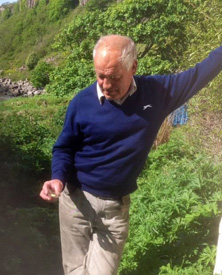 Up two steep fields, keeping left of the sheep as instructed, we arrived at the top of the cliff; our instructions were to continue along the top of the cliff until we encountered a “Large obvious stile”. We were to cross at the stile and descend through a wood, this would lead us on to the metalled road some 500 metres from our destination. We had arrived on Eigg kitted out for the ferry crossing and not knowing we were going to hike to our digs, we hadn’t discarded any outer garments. We finally arrived at the digs some hour and a half later, red faced, mud spattered with soaking wet feet and totally knackered, “Welcome to Eigg”!
Up two steep fields, keeping left of the sheep as instructed, we arrived at the top of the cliff; our instructions were to continue along the top of the cliff until we encountered a “Large obvious stile”. We were to cross at the stile and descend through a wood, this would lead us on to the metalled road some 500 metres from our destination. We had arrived on Eigg kitted out for the ferry crossing and not knowing we were going to hike to our digs, we hadn’t discarded any outer garments. We finally arrived at the digs some hour and a half later, red faced, mud spattered with soaking wet feet and totally knackered, “Welcome to Eigg”!
John arrived at the digs in the late afternoon with his Spanish volunteer, Sara, and we went for a short walk around the point. A cold wind was now blowing very strongly from the north/east and would continue to do so for our entire stay. With such a strong wind John was less than optimistic that we would do any meaningful birding. The resident birds would be hunkered down out of the wind and its direction indicated no migration. 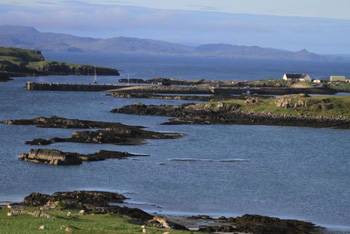 As Conservation Officer of Eigg, John's duties includes an annual bird breeding census, so he was able to show us nests with clutches of eggs in; these belonged to a Common Gull, Oystercatcher and Meadow Pipit. The Oystercatcher was interesting as it had laid its eggs on a carpet of Thrift, abandoning all attempts to camouflage its eggs in the nearby shingle.
As Conservation Officer of Eigg, John's duties includes an annual bird breeding census, so he was able to show us nests with clutches of eggs in; these belonged to a Common Gull, Oystercatcher and Meadow Pipit. The Oystercatcher was interesting as it had laid its eggs on a carpet of Thrift, abandoning all attempts to camouflage its eggs in the nearby shingle.
A long walk the next day produced a few warblers; these were found at the south of the Island which was a little more sheltered from the wind. If truth be told the birding was on the slow side to say the least. John did however manage to get us both mud-spattered with soaking feet and totally knackered for a second time. The birds we had hoped to encounter on the Island were Golden Eagle, Red-throated Diver, Hen Harrier, Short-eared Owl and Twite. Most of these required a long hike through boggy moorland or were "no shows". We did see Twite, but any hopes of photography were scuppered as our approach saw them lift on the strong wind and then be carried out of range. 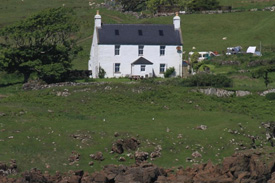 A fly-by Peregrine and a distant Hen Harrier were seen from the bus on our departure. It was good to catch up with John, although we felt our presence was more of a hindrance.
A fly-by Peregrine and a distant Hen Harrier were seen from the bus on our departure. It was good to catch up with John, although we felt our presence was more of a hindrance.
Accommodation on the island isn't plentiful, mainly guesthouses and self catering holiday lets. John recommended the Kildonan Guest House, just a couple of hundred yards from his cottage. Kildonan was a typical no nonsense affair; clean, good homely cooking and delightful hosts, a very pleasant Australian red wine (Yellow Tail - Shiraz), a large comfy bed, a roaring log fire to dry out our boots and socks and stunning views across the bay.
The return ferry trip was less eventful than the one going out, with just a few rafts of Guillemot seen. Our Ferry was again spot on time and the crossing took about an hour.
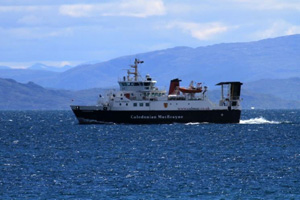 Birds Recorded on Eigg
Birds Recorded on Eigg
Shag, Gannet, Guillemot, Razorbill, Manx Shearwater, Common Gull, Fulmar, Great Skua, Arctic Tern, Buzzard, Peregrine, Hen Harrier, Oystercatcher, Common Sandpiper, Lapwing, Shelduck, Eider, Red-throated Diver, Mallard, Greylag Goose, Pheasant, Rock Dove, Collared Dove, Willow Warbler, Sedge Warbler, Whitethroat, Whinchat, Stonechat, Meadow Pipit, Rock Pipit, Skylark, Lesser Redpoll, Dunnock, Robin, Blackbird, Song Thrush, Wheatear, Pied Wagtail, Wren, House Sparrow, Tree Sparrow, Swallow, Sand Martin, Starling, Reed Bunting, Linnet, Twite, Goldfinch, Greenfinch, Chaffinch, Jackdaw and Hooded Crow.
THE CAIRNGORMS
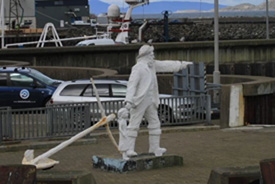 Arriving at Mallaig at a little after 14-00 to cool but dry conditions we embarked on the 3 hour drive to Nethybridge and our digs at Moidart, a bungalow in the grounds of the Mountview Hotel (Heatherlea).
Arriving at Mallaig at a little after 14-00 to cool but dry conditions we embarked on the 3 hour drive to Nethybridge and our digs at Moidart, a bungalow in the grounds of the Mountview Hotel (Heatherlea).
Once again the weather seemed to follow us. During our stay in the west the weather in the east of Scotland was dry and bright, now we were heading east the bright weather was in the west. With such bad luck weather-wise, I was beginning to suspect Jude had shot a Robin in her dim and dark past. We arrived at Mordart a little past 17-00; we unpacked and settled in, returning to the hotel for our evening meal. Breakfast was also to be taken in the hotel.
We awoke to more leaden skies and a fine drizzle which would intensify during the day. Several birds were on our wanted list here, Red & Black-throated Divers, Red Grouse, Crested Tit, Ring Ouzel and Golden Eagle, all Cairngorm specialities.
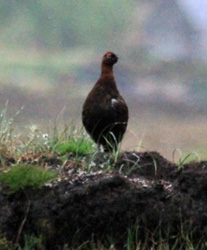 Our first port of call was Lochindorb for Black-throated Diver, then onto a small lochan on the A939 (Nairn road) for Red-throated Diver. With the birds on the far side of the Loch and the rain falling, the Black-throats were out. We did however get good views of a male Red Grousecalling from the top of a small mound.
Our first port of call was Lochindorb for Black-throated Diver, then onto a small lochan on the A939 (Nairn road) for Red-throated Diver. With the birds on the far side of the Loch and the rain falling, the Black-throats were out. We did however get good views of a male Red Grousecalling from the top of a small mound.
Our second port of call also drew a blank with no divers showing at all. With pretty low spirits we decided to call it a day and spend the rest of the day working on the trip report. We decided to make a quick call at a small lochan where we have always got Slavonian Grebe in the past. On arrival the first birds seen were two Slav's chasing each other. Although the light was diabolical we rattled off a few shots and then returned to Moidart.
.jpg) Our last day dawned very much as most mornings of the holiday, grey, overcast and wet. After breakfast we donned on our wet weather gear and walked part of the Abernethy Forest hoping for Crested Tit; several birds were seen but none photographable. During breakfast Jude had been told of a spot where Ring Ouzel had been seen the previous day, so we decided to cut our losses with the tits and try for the Ouzel.Arriving at the bottom car park for the Cairngorm ski-lifts we noted a group of birders with scopes and binoculars trained on the grass verge of the car-park: almost immediately Jude spotted a Ring Ouzel with a beak full of worms. By the time we had stopped it had flown so we decided to park up and wait; an inspired decision as within 10 minutes the bird was back giving cracking views. It was at this point that we decided to end the trip on a high and returned to the digs to pack, ready for an early start home.
Our last day dawned very much as most mornings of the holiday, grey, overcast and wet. After breakfast we donned on our wet weather gear and walked part of the Abernethy Forest hoping for Crested Tit; several birds were seen but none photographable. During breakfast Jude had been told of a spot where Ring Ouzel had been seen the previous day, so we decided to cut our losses with the tits and try for the Ouzel.Arriving at the bottom car park for the Cairngorm ski-lifts we noted a group of birders with scopes and binoculars trained on the grass verge of the car-park: almost immediately Jude spotted a Ring Ouzel with a beak full of worms. By the time we had stopped it had flown so we decided to park up and wait; an inspired decision as within 10 minutes the bird was back giving cracking views. It was at this point that we decided to end the trip on a high and returned to the digs to pack, ready for an early start home.
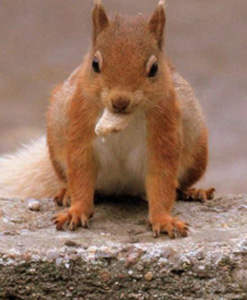 During our stay at the bungalow we were visited on both days by a Red Squirrel who was inquisitive enough to look through the French windows, we suspected he must get fed on a regular basis; he appeared to be carrying a dog biscuit when we snapped him.
During our stay at the bungalow we were visited on both days by a Red Squirrel who was inquisitive enough to look through the French windows, we suspected he must get fed on a regular basis; he appeared to be carrying a dog biscuit when we snapped him.
Birds Observed in the Cairngorms
Black-throated Diver, Slavonian Grebe, Goldeneye, Mallard, Curlew, Common Sandpiper, Lapwing, Common Gull, Black-headed Gull, Lesser Black-backed Gull, Osprey, Kestrel, Red Grouse, Grey Heron, Mistle Thrush, Song Thrush, Blackbird, Ring Ouzel, Great Spotted Woodpecker, Meadow Pipit, Northern Wheatear, Pied Wagtail, Spotted Flycatcher, Chaffinch, Greenfinch, Siskin, Coal Tit, Blue Tit, Great Tit, Crested Tit and Hooded Crow.
SUMMARY
Total cost of the holiday including diesel, but not including spending money was a tadge over £2k.
Total miles travelled: 1,567
Total number of bird species seen: 96
MOANS, GROANS and MEMORABLE MOMENTS
Moan - As the object of the trip was to get good quality photos for the bird library, then the trip was an unmitigated disaster. Less than half the birds we had hoped to see were encountered and, with the exception of the Corncrakes and possibly the Ring Ouzel, the photos were not of the quality required.
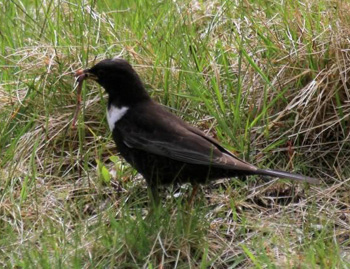 Groan - The weather: this was our third trip to Scotland when the weather has been dreadful; our last trip 4 years ago was abandoned half way through because of adverse conditions. We don't think there will be a fourth.
Groan - The weather: this was our third trip to Scotland when the weather has been dreadful; our last trip 4 years ago was abandoned half way through because of adverse conditions. We don't think there will be a fourth.
Moan - The Scarinish Hotel: threadbare carpets, wallpaper peeling from the walls, broken windows and poor food. It's such a shame because the location is to die for.
Memorable Moment - The great views of Corncrakes: even in our wildest dreams we didn't expect to see so many birds.
Memorable Moment - The Black Grouse Lek: this was by far the best view we have ever had.
Memorable Moment - The chancing upon the Ring Ouzel: again the best views ever.
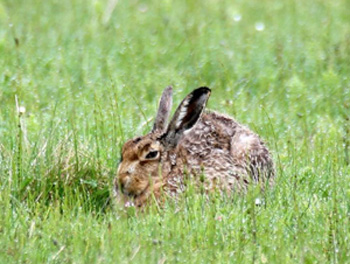 The order of the day for us when birding is sandals, shorts and tee-shirt with wall-to-wall sunshine. We have served our time in boots, thermals and waterproofs.
The order of the day for us when birding is sandals, shorts and tee-shirt with wall-to-wall sunshine. We have served our time in boots, thermals and waterproofs.
Bird Species List (Excel) or PDF
Trip Report PDF version
Bird Photos
Pat & Judy Hayes
